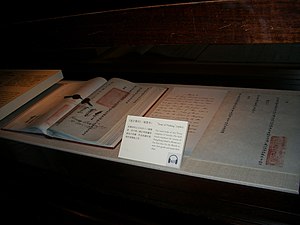Treaty of Nanking
| Treaty of Perpetual Peace and Friendship between Her Majesty the Queen of Great Britain and Ireland and the Emperor of China | |
|---|---|

Signing of the treaty on board HMS Cornwallis
|
|
| Type | Bilateral / Unequal |
| Signed | 29 August 1842 |
| Effective | 26 June 1843 |
| Condition | Exchange of ratifications |
| Parties | |
| Languages | English and Chinese |
|
|
|
| Treaty of Nanking | |||||||||||||||
 |
|||||||||||||||
| Traditional Chinese | 南京條約 | ||||||||||||||
|---|---|---|---|---|---|---|---|---|---|---|---|---|---|---|---|
| Simplified Chinese | 南京条约 | ||||||||||||||
|
|||||||||||||||
| Transcriptions | |
|---|---|
| Standard Mandarin | |
| Hanyu Pinyin | Nánjīng tiáoyuē |
| Hakka | |
| Romanization | Lam5/Nam5-gin1 Tiau2yok5 |
| Yue: Cantonese | |
| Jyutping | Naam2 ging1 tiu4 joek3 |
The Treaty of Nanking or Nanjing was a peace treaty which ended the First Opium War (1839–42) between the United Kingdom and the Qing dynasty of China on 29 August 1842. It was the first of what the Chinese later called the unequal treaties on the ground that Britain had no obligations in return.
In the wake of China's military defeat, with British warships poised to attack Nanking, representatives from the British and Qing Empires negotiated on board HMS Cornwallis anchored at the city. On 29 August 1842, British representative Sir Henry Pottinger and Qing representatives Qiying, Yilibu, and Niu Jian signed the treaty. It consisted of thirteen articles and was ratified by Queen Victoria and the Daoguang Emperor nine months later. A copy of the treaty is kept by the British government while another copy is kept by the Taiwanese (Republic of China) Ministry of Foreign Affairs at the National Palace Museum in Taipei.
The fundamental purpose of the treaty was to change the framework of foreign trade imposed by the Canton System, which had been in force since 1760. Under Article V, the treaty abolished the former monopoly of the Cohong and their Thirteen Factories in Canton. Four additional "Treaty ports" opened for foreign trade alongside Canton (Shameen Island from 1859 until 1943): Amoy (Xiamen until 1930), Foochowfoo (Fuzhou), Ningpo (Ningbo) and Shanghai (until 1943), where foreign merchants were to be allowed to trade with anyone they wished. Britain also gained the right to send consuls to the Treaty Ports, which were given the right to communicate directly with local Chinese officials (Article II). The treaty stipulated that trade in the treaty ports should be subject to fixed tariffs, which were to be agreed upon between the British and the Qing governments (Article X).
...
Wikipedia
